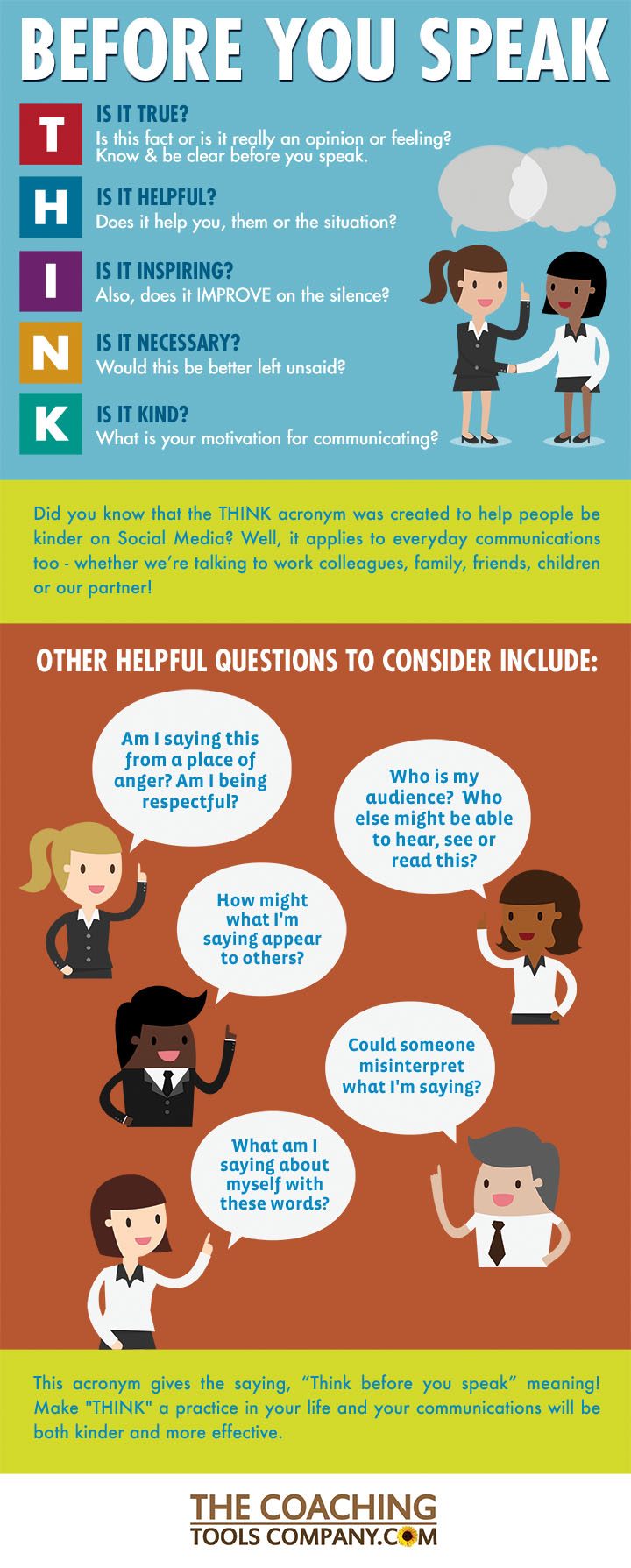This THINK acronym and infographic helps us communicate more kindly with others. Originally the THINK acronym was created to help reduce online bullying (to be used before posting something on Social Media), but it's actually useful for all our communications...
Where could you communicate more kindly with the THINK Acronym?
 To deepen your learning, ponder the questions below:
To deepen your learning, ponder the questions below:
- How could the THINK Acronym help your clients? How could you use this THINK acronym in workshops or groups?
- Where could THINK help you in your relationships (work, home, socially)?
- Where could you post this THINK infographic to reduce online (or other) bullying? Who else could find this acronym helpful?
Finally, if you liked this THINK Acronym Infographic on Kindness and Communication, you may also like:
- Be Brave – Be Authentic – Be Fabulous! By Ruby McGuire
- Healthy Conflicts: What's Underneath the Anger Costume? By Julia Menard
- 5 Conflict Tips and a Powerful Model to Make Your Conflict Conversations Run More Smoothly!


Hi Emma, do you know the original source of THINK? It is a great tool, thank you for sharing it! Warmly, Lynda
I did some research and couldn't find the original source. It seems to have originated as an anti-bullying acronym for social media posting. But sadly, no luck as to finding the origin! 🙂 Warmly, Emma-Louise
I believe it was made popular by Alan Redpath during his evangelist work in the '50s and early '60s. Still applicable today and a useful way to frame the messages we tell ourselves and others.
Thank-you Karina! I often wonder (and am asked) where the THINK acronym came from. I will look into Alan Redpath 🙂 Warmly, Emma-Louise
I knew the THINK acronym well before there was such a thing as "online" anything. Don't know who created it, but it didn't have anything to do with online bullying. However, it is a great acronym to live by and remind us that our words have consequences.
Same! My Dad, who is now 75 used to say this to us kids a lot (I’m 42). Way before social media ever existed. In fact before internet and DVD’s!
It's timeless! Your dad was onto something!
- Michela
i believe it is based upon a Buddhist saying: Before you speak, let your words pass through 3 gates: Is it true? Is it necessary? Is it kind?
Do all these need to be true? Sometimes something needs to be said that isn’t kind, but it is true, helpful, important....if we apply this to everything we communicate, everyday, why would we even speak our opinion on something?
Hi Fern,
Great comment! And I agree (personally). I think we can ALWAYS be kind - but that doesn't mean we aren't firm or even fiercely kind. In fact, I am in the process of developing a new practice/website and much more - based on exactly this, Fierce Kindness.
Kindness that is strong, protects boundaries and speaks the truth - is still kindness!
Warmly, Emma-Louise
I am looking to it as applicable only if we are talking about another person, it's how to avoid being critical/rude to others or gossiping about others.
I always told my kids that "Everything can be said but the manner in which you say is important. It's nice to be important but more important to be nice." So they were raised that they can speak their mind but also say it in the kindness way possible. 😀
Many times there are infographs...where can I get a copy of them as a poster like the "think' one?
Dear Pam, great question. You can always "right-click" on the image, save or copy the image and then print it if you'd like a copy to refer to! Warmly, Emma-Louise
I'm trying to find the source also. I've heard it for many years, way before social media.
Dear Peggy, well, if you ever do find the source, I'd love to hear about it. And if I find the source, I'll share it here too. Warmly, Emma-Louise
In 1932 A 4 Way Test was created by Rotarian Herbert J Taylor
1. Is it the Truth?
2. Is it Fair to all concerned?
3. Will it build Goodwill and Better Friendship?
4. Will it be Benefical to all?
Thank-you Pamela - that's lovely! I have heard it before, but didn't know where it was from 🙂 Warmly, Emma-Louise
Hello 🙂 I would like to share this graphic for a blog post I am doing. I would like to keep it attached to your website so coaches can find it. Let me know if this is okay with you, please 🙂
Hi Rocio, this is fine with us! We designed our infographics to be helpful - and shareable! Warmly, Emma-Louise
I found you in a Google search as I couldn't remember the "I" in THINK! I was given this back in the 1980s in management training programs, long before online bullying needed the refresher.
Hi Claudia, thank-you for your comment! That's great to hear - I've had trouble finding the origin of this acronym! It's been around for quite a while then! Warmly, Emma-Louise
From Claire ..............
June 13, 2018
i believe it is based upon a Buddhist saying:
Before you speak, let your words pass through 3 gates:
Is it true?
Is it necessary?
Is it kind?
Hi Lynda, that definitely fits the THINK Acronym. Thank-you for that reference 🙂 Warmly, Emma-Louise
I think the three gates it was a Sufi saying, not Buddhist
With each word that is spoken, let it edify the hearer
I found a little hand-made book of my mother's, when she was a little girl, that had this saying in it. And she quoted it to me once as well. This little book would have been made in about 1946. The difference was that "Inspiring" was definitely not the word for "I". That "Inspiring" part strikes me as very wrong. We should never speak unless we think our words are inspiring? If so, only narcissists would be talking. I believe the original might well have been "Important."
How interesting! Yes, maybe Inspiring isn't always possible but in the image it also says "Does it IMPROVE on the silence".
Here it becomes interesting. (No pun.) Although acronyms may be useful, the difference between Important and Necessary is often overlooked in this scenario. Also, a thought is easily lost in translation to the spoken word, and words that may trigger the listener don't really help (to convey the message, any message). With this in mind, Kind should alwas come first, imo. And then there is Inspiring, often misused for Motivating, and vv. Inspiring, Important, Necessary, Helpful and Interesting may well be within the Buddhist's Necessary. I wonder who translated the Buddhist saying into English? Also, in Al-Anon and Co-dependents Anonymous (CoDA) I came across different versions of the THINK tool.
It’s from the 12 step program, Al-anon. Z12 step programs are largely based on Buddhist principals.
My understanding is that the 12 steps are based on Judeo-Christian principles. Specifically it was based on the Sermon on the Mount, 1st Corinthians 13, and the book of James.
I could not remember Helpful or Inspiring and it kept my up at night until I googled it.
The most important (I think)is the other three; True, Necessary, Kind which came naturally to me.
I'm glad you resonate with the acronym, Ramos. Thanks for sharing!
Kindly,
Michela
The source of this acronym is universal, Buddha, Sufism, the bible etc. This THINK acronym is an evolution of those principles.
I also like these: One needs to be silent in order to listen. And both silent and listen use the same letters. And: everything you say needs to be true, but not everything that is true needs to be said.
I don't remember the first time I heard this but, as someone else commented, it IS tubeless! I am a Christian and it is a great "nutshell" for many scriptures that focus on our speech/talk. Specifically, I'm studying in James right now.
I personally learned THINK through AL-Anon. 🙂 I was out on the interwebs looking for a corporate way to integrate it at work as I am a people leader and voila. Thank you!
So glad you found this THINK Acronym Graphic helpful! 🙂 Warmly, Emma-Louise